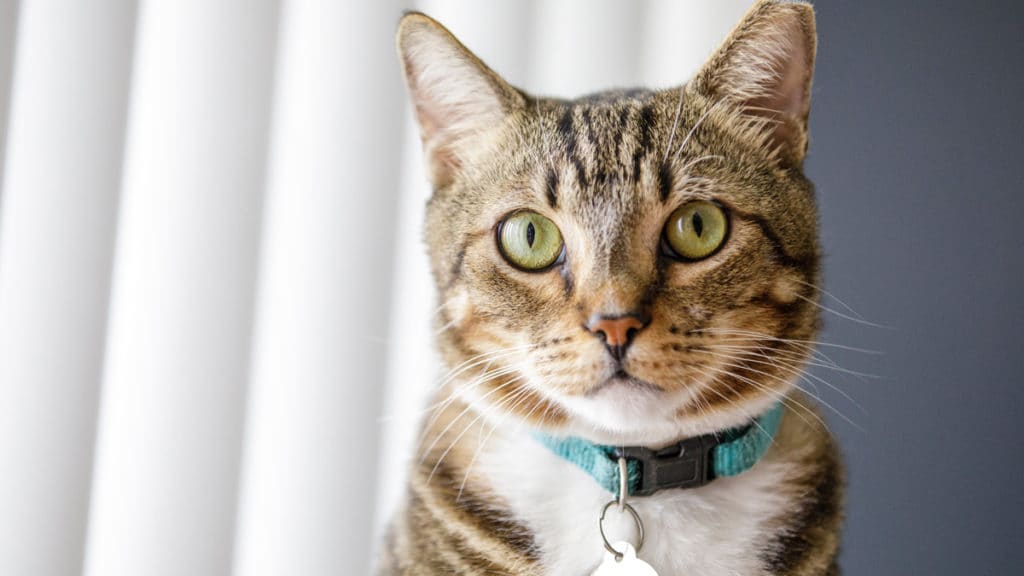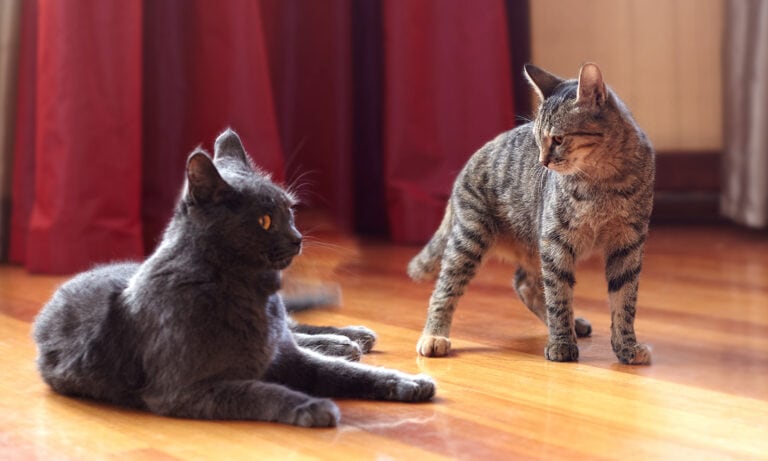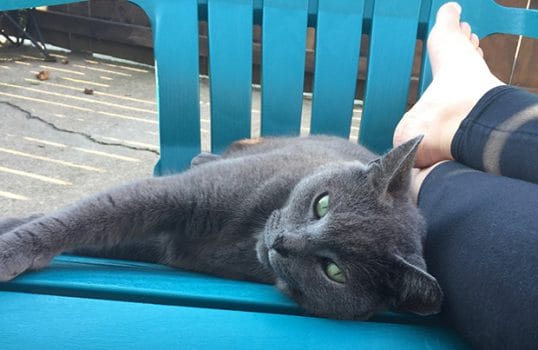Scientists agree that meowing is a form of cat language. Understanding the meaning behind your cat’s meows allows you to respond appropriately, which can strengthen the bond you share with your chatty feline. But there’s much more than just decoding the familiar meow when it comes to understanding cats. Take her body language, for instance. Let’s face it: hissing not withstanding, cats are a lot less transparent than dogs. If you think that a cat rolling on her back, exposing her belly, is an open invitation for a belly rub—think again. Here’s everything you need to know to translate your lovable kitty’s cat language:
Meows
When learning how to speak cat, it only makes sense to start with the most obvious form of cat communication: meowing. Cats in feral colonies rarely, if ever, meow at each other. So if a pet cat is meowing away, you can be reasonably sure it’s directed toward her humans. But beyond that, figuring out how to speak cat fluently takes patience and keen observation. As a general rule, “Conversational meows tend to be at a regular volume, and vary in pattern and pitch. Demand meows are louder and more repetitive. Distress meows are not only loud, but longer, often with a drawn out ‘owwwwwwww’ at the end,” explains Mary Molloy, CPDT-KA at Nirvana Tails in New York City.
Body Language
Interpreting cat body language involves understanding the various positions of their ears, eyes, nose, mouth and whiskers—and that only covers their faces! The environment (where cats are, what time of day it is, who’s around) also offers clues, notes Molloy.
-
Tails
The carriage and movement of a cat’s tail says a lot, but the differences are subtle and can be hard to discern. “Cats will loosely wave their tail if they are relaxed, but will more quickly or sternly flick their tail if irritated. A fearful cat will crouch while lowering her tail, while a focused cat will flick just the tip of his tail,” explains Toni Lynn Mark, KPA-CTP, training and behavior education specialist at PetSafe in Knoxville, TN.
-
Posture
Cats that are standing comfortably are likely content. Crouching with a flat body and feet underneath means your cat is ready to pounce, while lying on her side could indicate she’s ready to scratch with all four feet! “These postures mean the cat is frightened or agitated, and you should give the cat her space,” advises Jacqueline Munera, CAP 2, IAABC-CCBC, AABP-CCBC, and owner of Positive Cattitudes in Tampa, FL.
-
Kneading
A feline who looks like she’s kneading dough for biscuits is a super relaxed kitty!
-
Rubbing
When a cat rubs her nose or body on you, she is often marking you with her scent, but the action could be a sign of affection or anxiety, depending on the circumstances, says Mark. If you have an anxious cat, you could try the ThunderShirt Anxiety & Calming Solution, which will provide pressure to calm anxiety, fear, and over-excitement.
Myths Busted
When a Cat Turns Away
When a cat shows you her backside, with tail held high, it’s not an insult. It’s actually a friendly greeting. “Appreciate the cat butt!” encourages Molloy.
The Purpose of Purring
Most people think a purring cat is a euphoric cat, and that certainly is true sometimes. But what is less well-known, Munera points out, is that purring can also mean the animal is hurt, ill or stressed.
Tummy Time
When a cat rolls onto her back and shows you their belly, it’s seldom a request for a belly rub. It’s just a display of trust (after all, she’s exposing the most vulnerable part of her body—the soft underbelly). Take note: there are cats who love belly rubs, but most decidedly do not. Backs, legs and tails can also be problematic. But even when you’re petting the generally safe areas of the cheek, chin and head, stick to the 3-second rule, says Molloy. “Caress for 3 seconds, and then stop. If she moves in for more, go for 3 more seconds. If not, move along!” Cat parents who do not take hints are usually the ones talking about how their cat is all lovey-dovey one minute, and then “out of nowhere,” bites.
Nuzzling Might Be a No-No
Getting right up in a cat’s face for a nuzzle is not as appealing to them all those cat food ads would make it appear. In fact, it makes many cats downright uncomfortable, says Molloy. “Within about a foot of their faces, cats’ vision is extremely poor,” she explains. The best advice is to wait for them to nuzzle you.
When All Else Fails
If you’re still feeling clueless as far as reading cat body language and/or talking cat goes, just ask! Give your cat a chance to show you how she feels. Stand up and look at her, and follow her wherever she leads. Her destination should reveal her intention, whether that’s wanting you to bring fresh water, clean her litter box, or open the door to her favorite room.
Often, the only way to break your cat’s code is to just spend time watching her. “Even better, take video of her and watch it in slow motion,” says Molloy. If you don’t know which behaviors are “normal” for your pet, it will be nearly impossible to spot when her body language is off. “It is especially important to pay close attention to the cat’s normal tail movements and posture and to see how those change in new environments in order to properly assess the cat’s comfort level,” says Mark. You’ll be amazed at quickly you’ll be able to start “talking cat” when you keep your eyes and ears open.

Christina Vercelletto is a pet, travel and lifestyle content specialist and a former editor of Parenting, Scholastic Parent & Child, and Woman’s Day. She lives on Long Island with her Chiweenie, Pickles, and 20-pound Calico, Chub-Chub.
Share:












